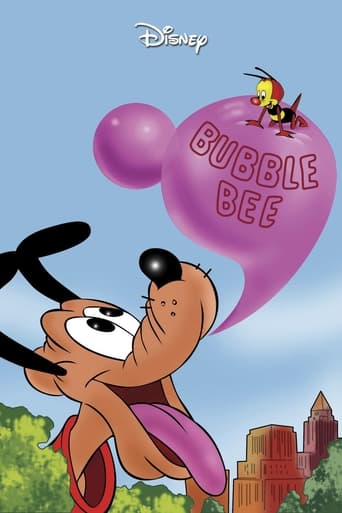OllieSuave-007
This Walt Disney cartoon short stars Pluto playing ball at the park. He later mistook a gum ball machine as the ball, and tries to get to the gum. When a bumble bee successfully snatches a gum-ball and takes it to its hive, Pluto follows it and knocks the hive down, along with its gum-ball stash. Pluto then scoops up all the gum-balls in his mouth and starts chewing and blowing bubbles, while trying to escape the upset bee at the same time.With all the sweet gum-balls, this cartoon makes you want to chew some gum-balls yourself. Every time I pass a gum-ball machine, I am reminded of this cartoon short. It's not one of the more exciting cartoons as it is just Pluto chewing gum and avoiding a bee. It's one of those cartoons that was part of an episode of the Wonderful World of Color. It's cute, but there are better ones out there with Pluto.Grade B-
TheLittleSongbird
I have always loved Disney, and while the story is very slight and doesn't break any new ground, it is a very nice cartoon. The animation is great, very fluid in the backgrounds and the colours are vibrant. The music has a lot of energy to it as well, and there are plenty of funny and cute moments to make up for the story. Pluto I have always found very likable, finding he is both a good foil and one that is easy to sympathise with, with the latter being the case here. The bee is suitably cute and antagonistic. Overall, a very nice and well done and definitely worth watching, but I have seen better ones with Pluto in. 9/10 Bethany Cox
Ron Oliver
A Walt Disney PLUTO Cartoon.Pluto and a persistent bee engage in a vigorous struggle over the control of some purloined bubble gum balls.While breaking no new ground, BUBBLE BEE is still an enjoyable little film. This was the second of seven cartoons, produced by Disney between 1948 & 1952, to feature Buzz-Buzz the bee, usually as an antagonist for Donald Duck.Walt Disney (1901-1966) was always intrigued by pictures & drawings. As a lad in Marceline, Missouri, he sketched farm animals on scraps of paper; later, as an ambulance driver in France during the First World War, he drew comic figures on the sides of his vehicle. Back in Kansas City, along with artist Ub Iwerks, Walt developed a primitive animation studio that provided animated commercials and tiny cartoons for the local movie theaters. Always the innovator, his ALICE IN CARTOONLAND series broke ground in placing a live figure in a cartoon universe. Business reversals sent Disney & Iwerks to Hollywood in 1923, where Walt's older brother Roy became his lifelong business manager & counselor. When a mildly successful series with Oswald The Lucky Rabbit was snatched away by the distributor, the character of Mickey Mouse sprung into Walt's imagination, ensuring Disney's immortality. The happy arrival of sound technology made Mickey's screen debut, STEAMBOAT WILLIE (1928), a tremendous audience success with its use of synchronized music. The SILLY SYMPHONIES soon appeared, and Walt's growing crew of marvelously talented animators were quickly conquering new territory with full color, illusions of depth and radical advancements in personality development, an arena in which Walt's genius was unbeatable. Mickey's feisty, naughty behavior had captured millions of fans, but he was soon to be joined by other animated companions: temperamental Donald Duck, intellectually-challenged Goofy and energetic Pluto. All this was in preparation for Walt's grandest dream - feature length animated films. Against a blizzard of doomsayers, Walt persevered and over the next decades delighted children of all ages with the adventures of Snow White, Pinocchio, Dumbo, Bambi & Peter Pan. Walt never forgot that his fortunes were all started by a mouse, or that childlike simplicity of message and lots of hard work always pay off.
